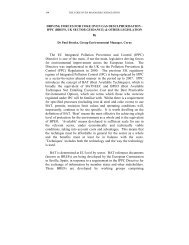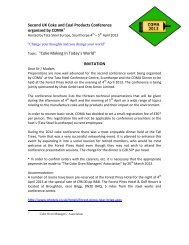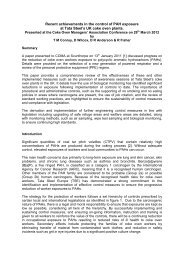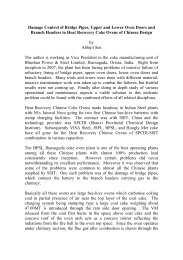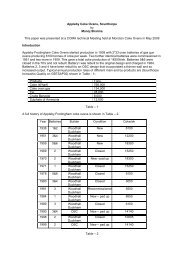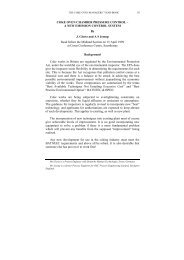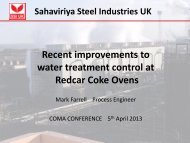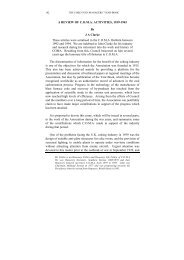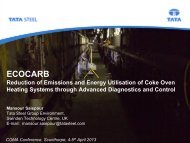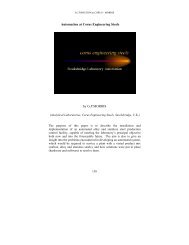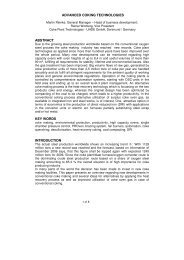Generic Methods for Coke Oven Gas Desulphurisation by Wilfried ...
Generic Methods for Coke Oven Gas Desulphurisation by Wilfried ...
Generic Methods for Coke Oven Gas Desulphurisation by Wilfried ...
- No tags were found...
You also want an ePaper? Increase the reach of your titles
YUMPU automatically turns print PDFs into web optimized ePapers that Google loves.
THE COKE OVEN MANAGERS’ASSOCIATION 197<strong>Generic</strong> <strong>Methods</strong><strong>for</strong><strong>Coke</strong> <strong>Oven</strong> <strong>Gas</strong> <strong>Desulphurisation</strong><strong>by</strong><strong>Wilfried</strong> SeyfferthRainer Dittmer, Dr. Holger ThielertThyssenKrupp En<strong>Coke</strong> GmbH, Bochum, Germany(now Uhde GmbH, Dortmund, Germany)COMA/ABB Engineering Services <strong>Gas</strong> <strong>Desulphurisation</strong> Seminaron 2 nd of April 2003 at ABB Daresbury Office.The purpose of this paper/presentation is to give an overview of themost common desulphurisation processes suitable <strong>for</strong> coke oven gas.But first we should ask the question why do we have to talk ordiscuss about desulphurisation processes.There is an increasing environmental pressure in reducing SO 2emissions which cause the so-called “sour rain” that impairs theenvironment and finally all living beings and plants.The regulations, there<strong>for</strong>e, are becoming more stringent and <strong>by</strong> theend of the year 2007 (current status) all coke plants in the EuropeanUnion will have to have the desulphurisation of coke oven gas processinstalled.But there are not only environmental requirements <strong>for</strong>desulphurisation of coke oven gas there are also technological andsafety requirements.In Fig. 2 you can find <strong>for</strong> example the environmental requirementson the limitation of SO 2 emissions according to the German TA Luft <strong>by</strong>limiting the S total in coke oven gas to max. 800 mg/m n 3 .
198THE COKE OVEN MANAGERS’ASSOCIATIONThe available processes suitable <strong>for</strong> desulphurisation of coke ovengas can be subdivided into three generic methods, namely• dry oxidative processes,• wet oxidative processes and• neutralization or absorption/stripping processes.In Fig. 3 you can see the most common processes <strong>for</strong> each of thegeneric methods.Dry Oxidative ProcessesThe Iron Oxide Process was used <strong>for</strong> the first time in the early 17 thcentury and the process has hardly changed since then. For theabsorption of hydrogen sulphide ferric hydroxide mass is utilised.An iron oxide process based plant mainly consists of cleaning,depositing and emptying towers with a certain number of baskets or ofboxes with layers of ferric hydroxide.As you can see from Fig. 5, oxygen <strong>for</strong> sulphur <strong>for</strong>ming is required(approx. 1 to 1.5 % vol. of oxygen). That means oxygen has to beadded to the coke oven gas. Due to <strong>for</strong>mation of water <strong>by</strong> the process,the coke oven gas should be slightly overheated be<strong>for</strong>e entering thetowers/boxes.By this process elemental sulphur is produced and <strong>for</strong>ms a layer onthe iron oxide mass and lowers the activity of the mass. There<strong>for</strong>e afterloading of the mass to a certain extent, this basket tower/box has to bechanged to a tower/box with fresh mass. In the beginning in using thisprocess big boxes were used, but later cylindrical towers have beenused because of operating the process at higher pressure and because ofless necessary space.Another way to adsorb hydrogen sulphide is the use of the ZincOxide Process.
COKE OVEN GAS DESULPHURISATION 199This process, however, is utilised to absorb only small amounts ofhydrogen sulphide because of the consumption of zinc oxide mass. Inaddition it has to be taken into account, that the coke oven gas has to beheated up to the adsorption temperature of approx. 300 °C.Wet Oxidative ProcessesThe particular feature of these wet oxidative processes <strong>for</strong>desulphurisation is the direct production of elemental sulphur.All wet oxidative processes (Fig. 3) utilise a reduction-oxidationcatalyst to facilitate the <strong>for</strong>ming of hydrogen sulphide to elementalsulphur. In Europe and northern America the most applied process isthe Stret<strong>for</strong>d Process.A Stret<strong>for</strong>d desulphurisation plant mainly consists of theabsorber/scrubber and the oxidizer, where the elemental sulphur is<strong>for</strong>med as froth/foam. This foam is fed to the slurry tank, to thecentrifuge and finally to the autoclave to improve the sulphur quality.The following chemical agents are required <strong>for</strong> the Stret<strong>for</strong>dprocess:• Sodium hydroxide as absorbents• Sodium vanadate <strong>for</strong> sulphur <strong>for</strong>ming• ADA (anthraquinone disulfonic acid) as catalyst <strong>for</strong>oxidation of sodium vanadateIn Figure 8 you can find the mainly occurring chemical reactions.Side reactions with hydrogen cyanite in the presence of elementalsulphur result in <strong>for</strong>ming of a high amount of thiocyanate (SCN - ) andalso thiosulfate (S 2 O 3 -- ) is <strong>for</strong>med; this will inactivate the scrubbingsolution and will lead together with the sluiced out vanadium to highlycontaminated waste water, which cannot be sent to a biological wastewater treatment plant. The waste water also contains quinone andhydrochinone compounds from ADA. All this results in a dramaticalincrease of COD in the sluiced out waste water and requires a separatetreatment plant.
200THE COKE OVEN MANAGERS’ASSOCIATIONThe process sequence of the Perox Process is similar to theStret<strong>for</strong>d Process.The chemical reaction steps are similar, too. The sulphur <strong>for</strong>ming isper<strong>for</strong>med <strong>by</strong> catalyst directly, however.The Perox process needs ammonia bearing coke oven gas. Ammoniais utilized as absorbent <strong>for</strong> hydrogen sulphide and the catalysthydrochinone (parabenzolchinone) is used <strong>for</strong> sulphur <strong>for</strong>ming. Sidereactions with hydrogen cyanite also lead to the <strong>for</strong>mation ofthiocyanate and thiosulfate.The other wet oxidative processes (Fig. 3) such as Takahax,Thylox, Fumaks and LoCat are comparable with the Stret<strong>for</strong>d andPerox processes, but using other absorbents and catalysts.All of these wet oxidative processes produce a high contaminatedwaste water, which make the addition of an elaborate treatmentfacilities necessary.Now, an overview of the third group of desulphurisation processes,the neutralization processes or also called absorption and strippingprocesses is given (Fig. 3).Neutralization ProcessesThese processes are characterised <strong>by</strong> absorption and stripping(desorption) of hydrogen sulphide and conversion into elementalsulphur or sulphuric acid as in a subsequently installed plants.The simplified flow sheet of the Sulfiban Process shows a typicalabsorption/desorption process with H 2 S scrubber, H 2 S stripper andheating equipment.In the reclaimer continuous removal of heat-stable salts isper<strong>for</strong>med. The removed hydrogen sulphide leaves the process as acomponent of the sour gas and can be processed either to elementalsulphur or sulphuric acid.
COKE OVEN GAS DESULPHURISATION 201As scrubbing agent <strong>for</strong> the Sulfiban Process a MEA-solution(monoethanolamine) is utilised. With the H 2 S also partial removal ofCO 2 , HCN and S ORG is achieved. In addition to the MEA-solutionchemicals are necessary as anti-foaming and anti-corrosion agents.At low temperatures (approx. 25 to 35 °C) the equilibrium is on theright side of the equation (absorption/scrubbing) and at highertemperatures like 110 to 130 °C the equilibrium is on the left side of theequation (desorption/stripping).In the waste water of the Sulfiban Process organic sulphurcompounds will be found.The standard process <strong>for</strong> the desulphurisation of ammonia-bearingcoke oven gas is the CYCLASULF Process. By this process hydrogensulphide and ammonia is removed simultaneously.The CYCLASULF Process mainly consists of the H 2 S and NH 3scrubbers and the deacidifier/NH 3 stripper. Most of the ammonia isremoved in the NH 3 scrubber using stripped water and most of thehydrogen sulphide is removed in the H 2 S scrubber <strong>by</strong> means ofdeacidified water.The removed hydrogen sulphide and ammonia are recovered asvapours in the deacidifier/ammonia stripper column.The stripping steam <strong>for</strong> the deacidifier/NH 3 stripper is fed directlyinto the column.The H 2 S/NH 3 rich vapours can be fed either to a COMBICLAUSplant where the ammonia is destructed and the hydrogen sulphide isprocessed to elemental sulphur or to an “indirect” ammonium sulphateproduction and sulphuric acid plant.Soda lye used <strong>for</strong> removing fixed ammonia compounds from the gasliquor, can be used first to reduce the residual hydrogen sulphide in thecoke oven gas.
202THE COKE OVEN MANAGERS’ASSOCIATIONThe main chemical reactions of the CYCLASULF Process areshown in Fig. 15.The standard process <strong>for</strong> the desulphurisation of ammonia-lean cokeoven gas is the VACASULF Process, in which the absorbed hydrogensulphide is recovered as sour gas in a regeneration process under partialvacuum.Due to the partial vacuum in the H 2 S stripper the temperature levelof the heating media can be very low.The heat required <strong>for</strong> regeneration of the potash solution is fed inindirectly. The heat requirement can be achieved either <strong>by</strong> sensible heatof hot water generated at the top of the primary cooler or flushingliquor be<strong>for</strong>e entering the collecting main of the coke oven battery or<strong>by</strong> low pressure steam.The mainly occurring reactions are stated in Fig. 17.For residual removal of hydrogen sulphide down to less than 2mg/m n 3 the Soda Lye Scrubbing Process can be used.This process unit would be installed downstream of other hydrogensulphide removal processes, <strong>by</strong> which the hydrogen sulphide content inthe coke oven gas is reduced, already.The utilised soda lye should not exceed the necessary soda lyeconsumption <strong>for</strong> removing fixed ammonia compounds from the gasliquor, however.A summary of aspects of desulphurisation can be found in Fig. 19.The conclusion is summarized in Fig. 20, 21 and 22.
COKE OVEN GAS DESULPHURISATION 203
204THE COKE OVEN MANAGERS’ASSOCIATION
COKE OVEN GAS DESULPHURISATION 205
206THE COKE OVEN MANAGERS’ASSOCIATION
COKE OVEN GAS DESULPHURISATION 207
COKE OVEN GAS DESULPHURISATION 209
210THE COKE OVEN MANAGERS’ASSOCIATION
COKE OVEN GAS DESULPHURISATION 211
212THE COKE OVEN MANAGERS’ASSOCIATION
COKE OVEN GAS DESULPHURISATION 213
214THE COKE OVEN MANAGERS’ASSOCIATION
COKE OVEN GAS DESULPHURISATION 215
216THE COKE OVEN MANAGERS’ASSOCIATION
COKE OVEN GAS DESULPHURISATION 217
218THE COKE OVEN MANAGERS’ASSOCIATION
COKE OVEN GAS DESULPHURISATION 219
220THE COKE OVEN MANAGERS’ASSOCIATION
COKE OVEN GAS DESULPHURISATION 221
222THE COKE OVEN MANAGERS’ASSOCIATION
COKE OVEN GAS DESULPHURISATION 223
224THE COKE OVEN MANAGERS’ASSOCIATION



